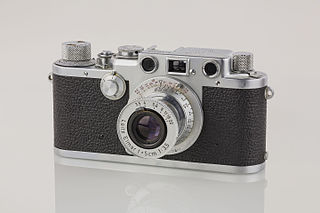
A camera is an optical instrument used to capture and store images or videos, either digitally via an electronic image sensor, or chemically via a light-sensitive material such as photographic film. As a pivotal technology in the fields of photography and videography, cameras have played a significant role in the progression of visual arts, media, entertainment, surveillance, and scientific research. The invention of the camera dates back to the 19th century and has since evolved with advancements in technology, leading to a vast array of types and models in the 21st century.

A view camera is a large-format camera in which the lens forms an inverted image on a ground-glass screen directly at the film plane. The image is viewed and then the glass screen is replaced with the film, and thus the film is exposed to exactly the same image as was seen on the screen.
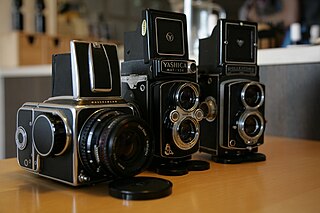
Medium format has traditionally referred to a film format in photography and the related cameras and equipment that use film. Nowadays, the term applies to film and digital cameras that record images on media larger than the 24 mm × 36 mm used in 35 mm photography, but smaller than 4 in × 5 in.
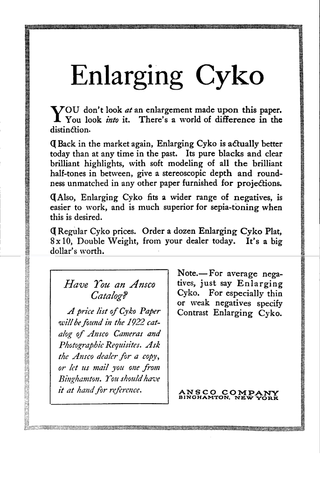
Photographic paper is a paper coated with a light-sensitive chemical formula, like photographic film, used for making photographic prints. When photographic paper is exposed to light, it captures a latent image that is then developed to form a visible image; with most papers the image density from exposure can be sufficient to not require further development, aside from fixing and clearing, though latent exposure is also usually present. The light-sensitive layer of the paper is called the emulsion. The most common chemistry was based on silver halide but other alternatives have also been used.
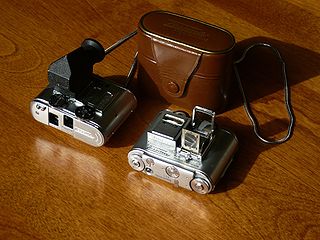
Subminiature photography is photographic technologies and techniques working with film material smaller in size than 35mm film, such as 16mm, 9.5mm, 17mm, or 17.5mm films. It is distinct from photomicrography, photographing microscopic subjects with a camera which is not particularly small.
Sheet film is large format and medium format photographic film supplied on individual sheets of acetate or polyester film base rather than rolls. Sheet film was initially supplied as an alternative to glass plates. The most popular size measures 100 mm × 130 mm ; smaller and larger sizes including the gigantic 510 mm × 610 mm have been made and many are still available today.

Large format refers to any imaging format of 9 cm × 12 cm or larger. Large format is larger than "medium format", the 6 cm × 6 cm or 6 cm × 9 cm size of Hasselblad, Mamiya, Rollei, Kowa, and Pentax cameras, and much larger than the 24 mm × 36 mm frame of 35 mm format.
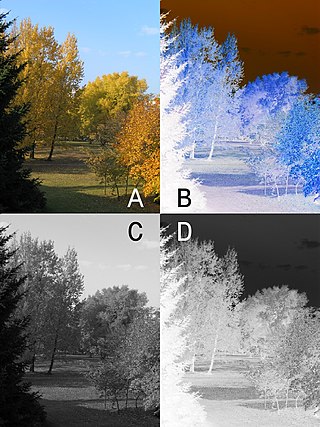
In photography, a negative is an image, usually on a strip or sheet of transparent plastic film, in which the lightest areas of the photographed subject appear darkest and the darkest areas appear lightest. This reversed order occurs because the extremely light-sensitive chemicals a camera film must use to capture an image quickly enough for ordinary picture-taking are darkened, rather than bleached, by exposure to light and subsequent photographic processing.

A darkroom is used to process photographic film, make prints and carry out other associated tasks. It is a room that can be made completely dark to allow the processing of light-sensitive photographic materials, including film and photographic paper. Various equipment is used in the darkroom, including an enlarger, baths containing chemicals, and running water.

The gelatin silver process is the most commonly used chemical process in black-and-white photography, and is the fundamental chemical process for modern analog color photography. As such, films and printing papers available for analog photography rarely rely on any other chemical process to record an image. A suspension of silver salts in gelatin is coated onto a support such as glass, flexible plastic or film, baryta paper, or resin-coated paper. These light-sensitive materials are stable under normal keeping conditions and are able to be exposed and processed even many years after their manufacture. The "dry plate" gelatin process was an improvement on the collodion wet-plate process dominant from the 1850s–1880s, which had to be exposed and developed immediately after coating.
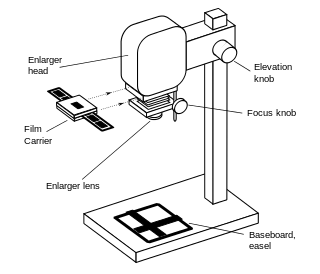
An enlarger is a specialized transparency projector used to produce photographic prints from film or glass negatives, or from transparencies.

A contact print is a photographic image produced from film; sometimes from a film negative, and sometimes from a film positive or paper negative. In a darkroom an exposed and developed piece of film or photographic paper is placed emulsion side down, in contact with a piece of photographic paper, light is briefly shone through the negative or paper and then the paper is developed to reveal the final print.
Photographic printing is the process of producing a final image on paper for viewing, using chemically sensitized paper. The paper is exposed to a photographic negative, a positive transparency , or a digital image file projected using an enlarger or digital exposure unit such as a LightJet or Minilab printer. Alternatively, the negative or transparency may be placed atop the paper and directly exposed, creating a contact print. Digital photographs are commonly printed on plain paper, for example by a color printer, but this is not considered "photographic printing".

Instant film is a type of photographic film that was introduced by Polaroid Corporation to produce a visible image within minutes or seconds of the photograph's exposure. The film contains the chemicals needed for developing and fixing the photograph, and the camera exposes and initiates the developing process after a photo has been taken.
A film holder is a accessory that holds one or more pieces of photographic film, for insertion into a camera or optical scanning device such as a dedicated film scanner or a flatbed scanner with film scanning capabilities. The widest use of the term refers to a device that holds sheet film for use in large format cameras, but it can also refer to various interchangeable devices in medium format or even 135 film camera systems.

Banquet photography is the photography of large groups of people, typically in a banquet setting such as a hotel or club banquet room, with the objective of commemorating an event. Clubs, associations, unions, circuses and debutante balls have all been captured by banquet photographers.
Dye transfer is a continuous-tone color photographic printing process. It was used to print Technicolor films, as well as to produce paper colour prints used in advertising, or large transparencies for display.

Photographic film is a strip or sheet of transparent film base coated on one side with a gelatin emulsion containing microscopically small light-sensitive silver halide crystals. The sizes and other characteristics of the crystals determine the sensitivity, contrast, and resolution of the film.
Paper texture effects in calotype photography limit the ability of this early process to record low contrast details and textures. A calotype is a photographic negative produced on uncoated paper. An important feature is that a relatively short exposure in a camera produces a latent image that is subsequently made visible by development. Then positive images for viewing are obtained by contact printing. This technique was in use principally from 1840 into the 1850s, when it was displaced by photography on glass. Skilled photographers were able to achieve dramatic results with the calotype process, and the reason for its eclipse may not be evident from viewing reproductions of early work.
The solar camera, or solar enlarger, is an ancestor of the darkroom enlarger, and was used in the mid-to-late 19th century to make photographic enlargements from negatives.













